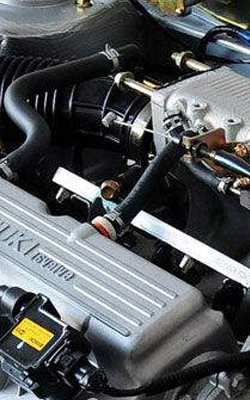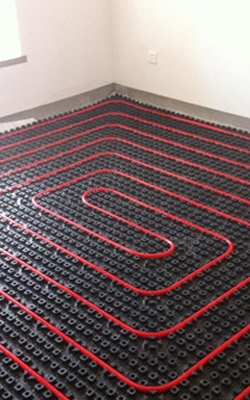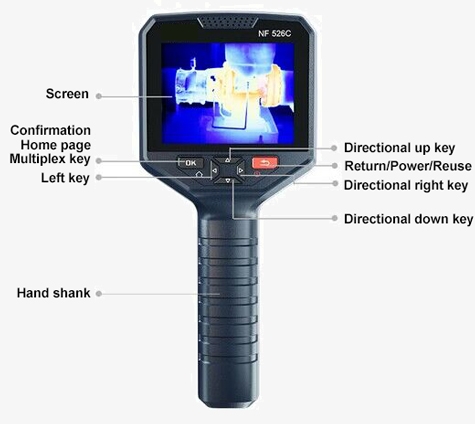SISCO thermal heat loss camera with a 256 x 192 infrared high resolution, 3.5-inch full-view TFT display, providing a comprehensive view of your inspections.The 25Hz frame rate ensures smooth and real-time thermal imaging, crucial for accurate and dynamic analysis in various applications.

- High-Definition LCD Display: The infrared thermal camera is equipped with a high-definition LCD display, ensuring clear and detailed visual output.
- 3.5-Inch LCD Screen: The thermal imaging machine features a 3.5-inch LCD screen, providing a compact yet effective display area for viewing thermal images.
- 256x192 Pixel Resolution: The digital professional infrared inspection camera with a resolution of 256x192 pixels, the thermal camera captures detailed thermal images, enhancing accuracy in temperature measurement and analysis.
- Wide Temperature Measurement Range: The SISCO IR thermal scanner can measure temperatures ranging from -20°C to 400°C, covering a broad spectrum of applications from industrial to environmental monitoring.
- 2 Megapixel Visible Light Camera: Equipped with a 2-megapixel visible light camera, this thermal imaging device delivers more detailed and vivid images, enhancing the clarity and precision of your thermal inspections.

- USB Transfer Function: The handheld infrared thermal camera includes a USB transfer feature and comes with 8GB of built-in storage, allowing for easy data transfer and ample space for storing thermal images and videos.
- Photo and Video Capture Capability: This compact infrared thermal imaging camera can capture both photos and videos, providing versatile options for documenting and analyzing thermal data.
- Built-in High-Sensitivity Sensor: This thermal imaging scanner equipped with a highly sensitive sensor, the camera ensures accurate and reliable temperature readings, enhancing the quality and precision of thermal imaging.
- Automatic High and Low Temperature Tracking: The professional infrared imaging camera automatically tracks high and low temperatures within the observed area, making it easier to identify critical points quickly.
- Built-in LED Flashlight: The affordable thermal detection camera includes a built-in LED flashlight, ensuring that images are clear and well-lit even in low-light conditions, making it easier to capture accurate thermal data in any environment.

- Eight Selectable Color Palettes: The IR thermography camera offers eight different color palettes, allowing users to choose the most suitable mode for various scenes and applications.
- Ultra-Wide Angle Lens: Equipped with an ultra-wide angle lens, the camera can cover large areas, facilitating efficient scanning and analysis of extensive zones.
- Rapid Image Refresh: The portable thermal imaging camera features a 56° x 42° wide-angle lens, providing extensive field coverage.
- Portable Design: Its compact and lightweight design makes it easy to carry and use in different locations, enhancing versatility.
Applications
SISCO handheld infrared thermal imaging camera is used for power line inspections, HVAC maintenance, building inspections, underfloor heating inspections, industrial mechanical and electrical inspections, energy audits, and leak prevention.

Electrical Inspections

Floor Heating

Electrical Maintenance

Water Leak Detection
| Model | SISCO-NF-526C | |
| Infrared Thermography Parameters | Resolution | 256x192 |
| Working Band | 8~14um | |
| Frame Rate | 70mK@25℃ | |
| NETD | 55.6° | |
| Lens | Athermal fixed focus lens | |
| Temperature Measurement Range | -20~150°C, High temperature: 120~400°C | |
| Temperature Measurement Accuracy | ±3°C or ±3% of reading | |
| Temperature Measurement | Supports temperature measurement at the highest point, lowest point, center point of the entire screen | |
| Swatches | Iron Red, White Hot, Black Hot, Rainbow, Red Hot, High Contrast, Green Hot, Lava | |
| Visible Light | Resolution | 720P |
| Field of View | 55°x 83° | |
| Image Display | Screen Size | 3.5 Inches |
| Image Mode | Edge fusion, overlay fusion, picture-in-picture, single infrared, single visible light | |
| Universal | Language | Chinese (Simplified/Traditional), English, French, German, Spanish, Dutch, Japanese, Korean, Arabic |
| Interface | USB Type-C (supports charging and data transfer) | |
| Battery | 2600mAh lithium battery | |
| Operating Hours | When the battery is fully charged, it can be used for about 4 hours | |
| Operating Temperature | -10°C~+60°C | |
| Storage Temperature | -40°C~+85°C | |
| Dimension | 70mmx80mmx200mm | |
| Weight | 310g | |
| Storage | Capacity | 8G built-in memory, can store more than 20,000 pictures |
| Image Storage Format | JPG | |
| Recording Video Format | MP4 | |
Details


Q1: How does a thermal imaging camera work?
A1: Thermal imaging camera works by detecting infrared radiation, which is emitted by all objects based on their temperature. The camera's sensor captures this radiation and converts it into an electronic signal. This signal is then processed to create a thermal image or thermogram, where different temperatures are represented by various colors or shades of gray, allowing users to visualize heat patterns and temperature variations.
The camera uses a special lens to focus the infrared light emitted by objects in its field of view. Inside the camera, a phased array of infrared-detector elements creates a detailed temperature pattern called a thermogram. This thermogram is translated into electric impulses, which are then processed by the camera's circuitry to produce a visible image on the display, illustrating the heat distribution of the scene. This technology is widely used in various applications such as detecting termites and mice, conducting electrical and HVAC inspections, firefighting, locating water leaks, and performing building and home inspections.
Q2: Can an infrared thermal imaging camera detect water leaks?
A2: Yes, an infrared thermal imaging camera can effectively detect water leaks. It identifies temperature variations on surfaces, which can indicate the presence of moisture. When water leaks occur, they often cause cooler or warmer spots on walls, floors, or ceilings due to the difference in thermal conductivity compared to dry areas.
By using the thermal imaging camera, technicians can quickly and non-invasively locate the source of the leak without needing to dismantle structures. This makes it a valuable tool for early detection and repair, preventing further damage and reducing maintenance costs.
Q3: Can an infrared thermal imaging camera be used outdoors in various weather conditions?
A3: Yes, infrared thermal imaging cameras can be used outdoors in a variety of weather conditions. They are designed to detect temperature differences and can function effectively in both day and night. However, certain environmental factors like heavy rain, fog, or extreme temperatures can affect the clarity and accuracy of the thermal images. For optimal performance, it is advisable to use the camera in conditions where visibility is not severely obstructed. Additionally, many models are built to withstand harsh outdoor conditions, including being resistant to dust and water, ensuring durability and reliable operation in different environments.
Tips: What is a thermal heat loss camera?
A "thermal heat loss camera" is a type of thermal imaging camera specifically designed to detect and visualize heat loss from buildings or structures. These cameras capture infrared radiation emitted by objects and surfaces, which is then translated into thermal images. By analyzing these images, professionals can identify areas where heat is escaping from a building, such as poorly insulated walls, windows, or doors.
Thank you for buying industrial test and measurement equipment on SISCO.com, all products sold by SISCO and the partner cover a 12 months warranty, effective from the date of receiving the products.
What is covered?
SISCO is responsible for providing free spare parts, and free technical support to assist the customer to repair the defective products until the problem is solved.
What is not covered?
- Product purchased from anyone other than a SISCO store or a SISCO authorized reseller.
- Expendable parts.
- Routine cleaning or normal cosmetic and mechanical wear.
- Damage from misuse, abuse or neglect.
- Damage from use of parts other than SISCO approved.
- Damage from use outside the product’s usage or storage parameters.
- Damage from use of parts not sold by SISCO.
- Damage from modification or incorporation into other products.
- Damage from repair or replacement of warranted parts by a service provider other than a SISCO authorized service provider.
- Damage caused by the application environment not meeting the product usage requirements and the failure to perform preventive maintenance.

